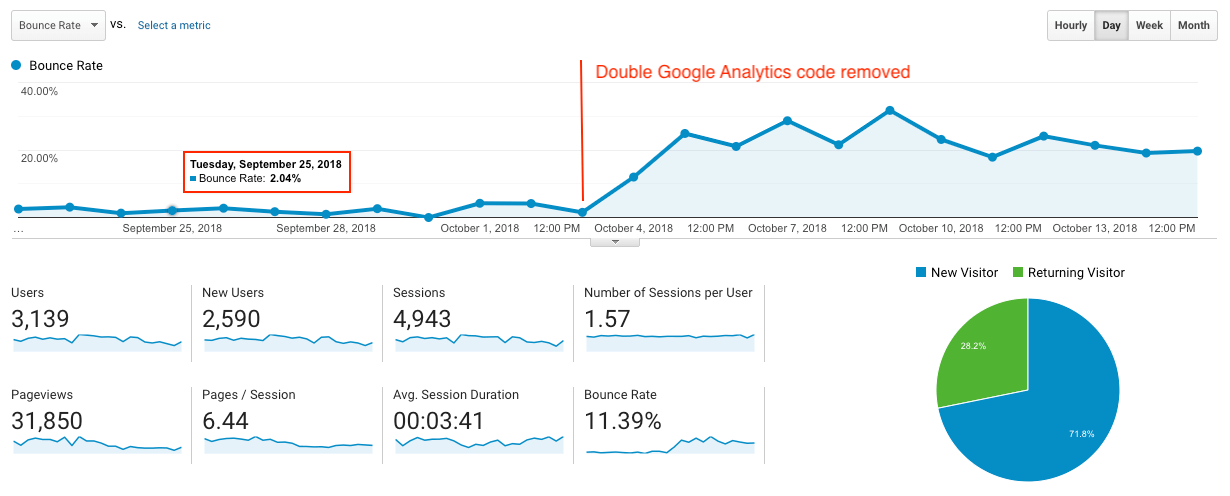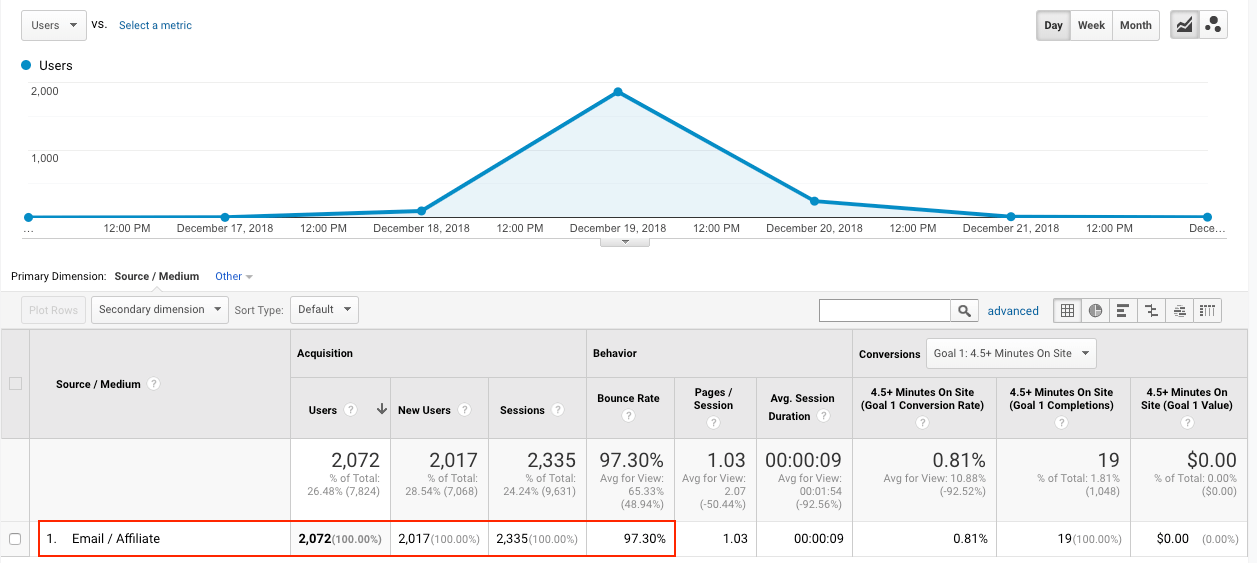
Did you open up Google Analytics and notice your bounce rate rising? Are you starting to panic thinking something must be horribly wrong? You are not alone. Rising bounce rates have become synonymous with poor website performance, but that is not always the case. Increasing and decreasing bounce rates can both be positive, negative, and completely normal signs of campaign performance. The success in proper identification, is to dig deeper into the data to define what is truly happening.
What is bounce rate?
The first thing to understand before we go any further is knowing what a bounce is and how bounce rate is calculated.
Bounce
A bounce in Google Analytics means that someone visited a single page on your website and left without visiting another page or triggering another request.
Potential pitfall: A common thought is that when someone bounces, it means only one page was visited then the individual left. While this is sometimes true, it is not always the case. Whether it’s a considered a bounce or not is more tied to page interaction (and even automated actions) than the amount pages visited. Interacting with a link would have the safe effect as pressing play on a video or clicking a button that generates a popup. Your website can even be configured to generate an event (which would then not count as a bounce) by scrolling down a certain % of a page or even just from being on that page for a certain length of time, although these require more advanced configuration.
Depending on the goals of the specific page, these more advanced modifications can provide a clearer picture of page success. However, if implemented without careful consideration, they can skew data and provide misleading insights – low bounce rates are not automatically a good sign.
Bounce Rate
Bounce rate is simply the percentage of sessions that incurred a bounce. So, if you have a bounce rate of 40%, it means that 40% of the visitors bounced, while 60% did not.
What is a good bounce rate?
Simple – the goal is to have a 0% bounce rate on every page, right? No. Not only is this just unrealistic, there are situations we run into regularly where an increase in bounce rate is a good sign, and an ultra low bounce rate is a bad sign. There are also many situations in which the website data is providing a limited scope on user action. A visitor bouncing does not necessarily mean the page was ineffective at achieving its goal.
Misleading Bounce Rate Scenarios
UX, SEO & Bounce Rate
To begin to illustrate the initial complexity of bounce rate analysis (and the pitfalls of generalized thinking), let’s think of a simple scenario that someone was looking for service for their Ford F-150, so they search in Google: ‘Ford dealership service’
Situation 1: Poor UX, great bounce rate
While your dealership offers service for Ford vehicles, you do not have a Service page, so only your Home Page shows in the search results for this query. The user clicks into your website, then makes a few additional clicks trying to locate your service department. They are never able to find the page, get the impression that you do not provide service, and leave the website.
- This session would display a 0% bounce rate, but it provided a very poor user experience, and in the end you did not get the lead.
- Outcome: 0% bounce, no lead
Situation 2: Great UX, poor bounce rate
Your well optimized Service Department page shows up first in the search results for this query, the user clicks the page, locates the clearly displayed phone number, types it into their phone and closes out the page.
- In this scenario, the page was extremely efficient in delivering what this user was looking for while acquiring a lead for your service department, however, your website data would display a 100% bounce rate for this session.
- Outcome: 100% bounce, service department lead
Situation 3: Great SEO, increasing bounce rate
You discover that you are missing leads because you do not have a Service Page (Situation 1), and you build a new Service Department page and begin getting an influx of new service leads (Situation 2).
- In this scenario, your bounce rate would increase from the previous 0% to 100% (respectively for these sessions), but your website has provided a much better user experience and is acquiring more leads.
- Outcome: 50% Increase in Bounce Rate, service department lead
Key Takeaway: As you can see, good SEO and website management can increase your sitewide bounce rate quite a bit. However, if the end goal is leads, this is a very successful campaign.
Website Configuration & Bounce Rate
Going a little deeper, we analyze situations that are not even based on user traffic or their experiences with your site, but how you have implemented the codes to track data.
Situation 4: Double Codes, amazing bounce rate. Fixed codes, raise in bounce rate
Another scenario we run into is a website that had the same Google Analytics code added twice. This creates unnaturally low bounce rates sitewide (sometimes even <5-10%). To fix this issue, the redundant code must be removed.
- Once your tracking codes have been implemented properly, your bounce rate will skyrocket, but you will be getting accurate data.
- Outcome: 300-500%+ potential increase in bounce rate, accurate data

Key Takeaway: Very low bounce rate should raise flags just as very high bounce rates, and data can be skewed very easily by simple mistakes with tracking code implementation. Bounce rate increases can also be signs of a well-functioning website.
Traffic Sources & Bounce Rate
Some traffic channels can bring dramatic swings in bounce rate. Bounce rate is not always a product of a poor website function, but can be a product of the type of traffic that the channel brought.
Situation 5: Email campaigns; high traffic, high bounce
You decide to run an email marketing campaign. You get a massive list of potential customers and send it out to blanket a local region.
- In this scenario, one massive email campaign can generate a lot of visitors, but the quality of this traffic is typically not the best and can bring very high bounce rates. In the example below, we see 1000s of visitors with a 97% bounce rate.
- Outcome: High potential of visitors, extremely high bounce rates

Key Takeaway: Not all swings in bounce rate are due to a website performing poorly, they are also due to the quality of traffic you bring in through multiple channels. Check your channels/sources for large traffic influxes and the bounce rates associated with those channels.
Page Types & Bounce Rate
Depending on the goal, position in the sales funnel, and type of page it is, bounce rates should have different acceptable ranges.
Situation 6: Upper funnel targeting
You design a page to target individuals in the research-phase of car buying by creating a page detailing popular searched features of a new vehicle at your dealership. While you are targeting locally, this page ends up ranking nationally and showing up 1st on Google for a host of popular search terms.
- In this scenario, your dealership will get a ton of local exposure (and national exposure), your content can help build the authority of your entire website (which helps other important pages rank on your site), you can get rich snippets & links, and they create return visitors that end up converting. Because these pages can cast a very wide net, they typically generate higher bounce rates, but they also have longer page durations.
- Outcome: High potential of visitors, higher bounce rates, high returning visitor/lead probability
Key Takeaway: Pages that have high bounce rates are not necessarily bad pages. While the Research-phase content has higher bounce rates, they are very beneficial in providing a ton of local exposure, building consumer trust, and building authority on Google (which helps with ranking and potential links).
So are you trying to tell me that looking at bounce rate is pointless?
Absolutely not! However, bounce rate must be viewed on a page-by-page/situation-by-situation basis, and must be used in conjunction with other data to get the full picture. A critical error while analyzing bounce rate is viewing sitewide increases as bad and decreases as good without any further thought. Forming conclusions based on a single metric with a limited scope, will typically always yield misguided results.
Final Takeaway: Never make generalized conclusions based on sitewide data, break the data down and get more granular. Great SEO and UX can raise your bounce rate, and that’s not necessarily a bad thing. If your bounce rate numbers seem too good to be true, they probably are. Understand the goal of your pages, marketing campaigns, and sales funnel, and how they can affect bounce rates.
We’re Here to Help
Still struggling to find the source of your bounce rate anomaly? Looking for guidance on how to improve bounce rate on pages that are really struggling? Have questions about whether you have a bounce rate issue at all? Leave a comment below or shoot us an email!
What’s your story?
Have you run into another situation where your bounce rate was affected by something out of the ordinary? Add it to the comments section below, I’d love to hear about it!
